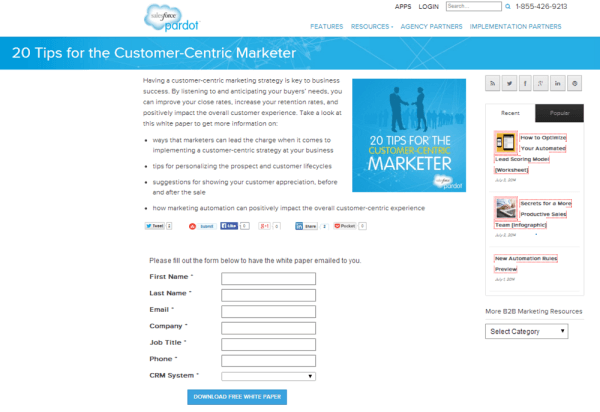Should You Gate Content? The SEO Implications
Content marketing is the hot topic these days, but lead generation marketers are faced with a conundrum: How do I get the visibility for my content via organic search while at the same time capturing leads? Are SEO and gated content mutually exclusive? There’s no magic answer to this question, but there are some important considerations […]
Content marketing is the hot topic these days, but lead generation marketers are faced with a conundrum: How do I get the visibility for my content via organic search while at the same time capturing leads?
Are SEO and gated content mutually exclusive? There’s no magic answer to this question, but there are some important considerations to address in order to decide your course of action.
Search Robots ≠ Humans
First and foremost, from an SEO perspective, it’s important to understand that search engine robots and humans are not equal. Search robots navigate and read a site very differently than a human will, and search robots can’t always perform the same tasks that a human will on a website.
Gating content involves adding a lead generation form in front of the content in some way, essentially blocking human visitors from viewing the content without providing information via a form.
But search robots won’t fill out forms; they don’t have a name, email address or phone number. Search bots view most forms as almost a brick wall — gating the content from humans essentially walls it off to search robots.
Think About The Content’s Purpose, Promotion and Value
When I’m deciding which content to gate, I think about what the content’s purpose is. What is its goal? For example, if the goal is to encourage inbound links, then gating the content will potentially hinder you — the gate presents a barrier to consumption.
Along with the goal, I consider how I’ll be promoting that content. For example, if the goal of the content is to encourage sharing via social networks, infographics work nicely. However, if I allow people to freely share the infographic via social media, there’s no incentive for prospective leads to visit the site and fill out the lead capture form, since they’ve already consumed the content elsewhere.
Finally, I consider the value of the content. Often, when I speak about landing pages and conversion, I talk about information currency. A site visitor’s information is a type of currency. When the visitor sees an offer, be it for a piece of content or otherwise, the visitor considers the value of that content. How much currency is it worth? Is it worth a visitor’s email address and name? Phone number? Is the content worth 20 form fields or three? As a content producer, I estimate that value, but I typically break it down into two categories: worth offering currency and not worth offering currency.
These three factors — purpose, promotion and value — may mean that some content may not be gated on the site but other content is.
Ranking Content And Gating It Simultaneously
Once you’ve decided to gate some (or all) of the content on your site, you’ll need to promote it. As mentioned above, if there’s no direct link path to the content so that the search bots can get by the form (as human visitors would), then you risk blocking the bots from this content — and thus blocking the content from being indexed and ranked.
There are, however, two creative approaches you can use to gate content and still provide a gateway to the search bots.
Preview/Summary Pages with Gates
Preview or summary pages essentially provide a snippet of the information — like an executive summary — to visitors prior to being presented with a gate. Preview pages also provide an opportunity to share a summary with the search bots which can then be indexed and ranked, drawing organic traffic to the preview page.
I find this to be one of the more common approaches to balancing both SEO and lead generation requirements. Here’s an example of Pardot’s summary page for a resource on its website:
The clear benefit of this page is that it allows the brand to add a keyword-rich summary page, well-optimized for SEO, and to provide a way for the visitor to sign up on the same page.
Javascript Pop Over Gates
Tread lightly using this approach. If misused, search engines may consider this approach “cloaking” and may penalize your site for it. Nonetheless, this approach clearly makes sense in certain situations to help both the search robots and the user have the most streamlined experiences on the site.
First, what do I mean by “cloaking”? Google defines cloaking as “the practice of presenting different content or URLs to human users and search engines.” In other words, if you intentionally show a human visitor something different from what you show a search engine robot, this could technically be considered cloaking by Google’s definition.
However, using gates — including pop-up gates — is not a new practice. Many publications, such as newspapers and magazines, have used paywalls for many years, sometimes using Javascript pop-overs as a way for visitors to pay to access more information. As an example, the New York Times has a paywall that appears as a pop-overonce you have viewed 10 articles in one month:
In fairness, while technically this page is showing something to the human visitor (me) that is different from what search engine robots see, the New York Times feels this is a necessary approach to monetize its web traffic.
Google has said that paywalls may result in reduced visibility in the search results. In a 2009 interview with Danny Sullivan, Josh Cohen of Google News addresses paywalls, indicating in the article that Google isn’t necessarily opposed to them, but cloaking has to be considered and avoided.
Many sites use the Javascript pop-over for everything from paywalls to ads. Why not also use this approach for lead generation forms?
Tips for Creating Marketing Gates
If you do choose to gate content, here are a few tips you may consider following to improve user engagement as well:
- Only Require One Form Fill Per Session. While many marketing automation tools enable forms to collect a multitude of information through progressive profiling, be judicious. If a visitor comes to your site to absorb multiple pieces of content, consider only requiring one form fill per session/visit.
- Consider The Content’s Worth In Information Currency. Multiple studies over time have shown that too many form fields can kill conversion. Consider how much “currency” is required for a piece of content.
- Consider Adding Social Login. Social logins can make it fast and easy for visitors to sign up for content access with essentially one click. On my own website, we use LinkedIn logins, and we’ve found about 10% of visitors choose this option.
- Use Progressive Profiling Or Bypass Forms. If a visitor has been to your site before and previously filled out a form, don’t make that person fill it out again! If you’re asking for new information via progressive profiling, that’s fine, but don’t keep making visitors fill out the same information over and over to view content.
Most importantly, remember that if you do choose to gate content, the search robots cannot get past the gate without one of these workarounds. So be sure to allow search robots access to some level of content (preview or the content itself) to help with indexing.
Stock image used with permission of Shutterstock.com
Contributing authors are invited to create content for Search Engine Land and are chosen for their expertise and contribution to the search community. Our contributors work under the oversight of the editorial staff and contributions are checked for quality and relevance to our readers. The opinions they express are their own.
Related stories

